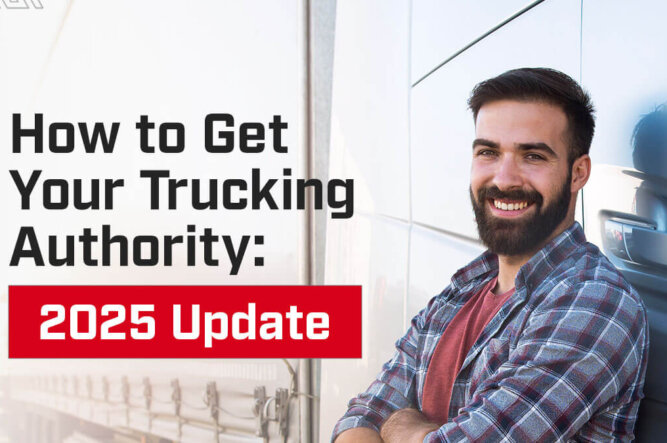How to Get Your Trucking Authority: 2025 Update

What are you waiting for?
Make more money starting now.
TL;DR
Getting your trucking authority involves understanding what it is, applying for your USDOT and MC number, securing necessary permits, enrolling in drug and alcohol testing, getting insurance, and preparing for audits.
Trucking is an essential industry. Everything from food to electronics needs transport. As an owner-operator, you work for yourself and have control over your hours and pay. Getting your own trucking authority is the first major step to becoming an independent owner-operator in the trucking industry. It allows you to legally operate your own business, haul loads across state lines, and manage your hours and income.
The FMCSA oversees interstate commerce and works to help keep our roadways safer. Registering with the FMCSA requires your trucking authority and ensures your compliance on the road.
So, how do you get started? Here’s a quick overview:
- Understand what trucking authority is: your legal permission to operate as a motor carrier in the U.S.
- Apply for your USDOT and MC number, the first steps to registering with the Federal Motor Carrier Safety Administration (FMCSA).
- Secure necessary permits, including UCR, HVUT, IRP, and IFTA.
- Enroll in drug and alcohol testing, mandatory before hitting the road.
- Get insurance. Liability and cargo insurance are non-negotiable for compliance.
- Prepare for audits. Stay compliant with FMCSA regulations by keeping thorough records.
Now, let’s break it down in more detail, starting with what trucking authority is and why it’s crucial to your success as a motor carrier.
What is a trucking authority and why is it important?
Trucking authority, also known as operating authority, is the legal permit you need to start your own trucking business. Without it, you won’t be able to haul loads across state lines or transport federally regulated commodities. It also acts as a key identifier for your business in the industry, tracking your safety records and compliance. Whether you’re hauling goods for a private company or want to expand into new freight markets, securing your authority is a non-negotiable step.
USDOT and MC numbers
The first step in operating as a trucking authority in the United States means securing a U.S. Department of Transportation (USDOT) and docket number. Your docket number could be labeled as an “MC,” “FF,” or “MX” number, depending on your authority. You’ll get an MC (motor carrier) number if you need operating authority to transport across state lines or move regulated commodities.
Your MC and USDOT numbers act as business identifiers. They track your safety records and compliance status and show your legitimacy in the industry. However, having different numbers can get confusing. That’s why, starting in 2025, the FMCSA is making the following changes:
Important 2025 update: changes in trucking authority
The FMCSA is updating its registration system to make registration and tracking easier. Beginning in October 2025, MC numbers will be eliminated so that new and registered entities enjoy a centralized platform with real-time tracking and improved security measures.
All entities will use a single USDOT number with a suffix designating authority type. The USDOT number will be the main identifier for the industry, hopefully reducing the confusion that multiple numbers cause.
The new system also incorporates improved verification software and enhanced validation checks to help reduce risk and make the compliance process easier. All in all, users will enjoy a centralized system with enhanced security.
What does it mean to have your own trucking authority?
Having your trucking authority, also known as operating authority and motor carrier authority, means you can legally operate as your own trucking company. There are different types of motor carrier operating authorities, and some carriers need multiple authorities to haul different types of cargo. Your authority depends on the cargo you’re hauling. For example, some states require intrastate authority if you’re moving loads within their borders. Make sure you apply for the operating authority or authorities relevant to your business. And keep in mind, the process can take upwards of two months.
Which carriers don’t need a trucking authority?
Several motor carrier categories do not need an operating authority, including:
- Private carriers that haul their own freight.
- Carriers that exclusively haul cargo that is not federally regulated.
- A trucking company operating exclusively within federally designated commercial zones that are exempt from interstate authority rules.
SEE ALSO: What Is Hot Shot Trucking?

How much does it cost to get your own trucking authority?
Federal operating authority costs $300 per type of cargo hauled. State-level authorities may also be required and come with additional costs. If your trucking authority is revoked by the FMCSA, reinstatement of your authority costs $80.
What are the benefits of having my own trucking authority?
The benefits of having your own trucking authority are significant, especially for those looking to transition from being a company driver to an independent owner-operator. Here’s a closer look at why getting your own trucking authority can be a game-changer:
1. Full control over your business
Having your own trucking authority gives you the freedom to run your business on your terms. You get to decide which loads to haul, set your own schedule, and determine which routes you take, providing a sense of independence and flexibility.
2. Higher earning potential
When you work under your own authority, you eliminate the need to share profits with a company. This means you keep 100% of the revenue from the loads you haul, which can lead to significantly higher earnings, especially if you manage your operations efficiently.
3. The ability to build your own fleet
As you grow your business, having your own authority gives you the option to expand by hiring additional drivers and purchasing more trucks. Over time, you can build a fleet and manage a larger operation, further increasing your revenue potential.
4. Direct relationships with shippers and brokers
Operating under your own authority allows you to establish direct relationships with shippers and brokers, giving you more negotiating power when it comes to setting rates and securing loads. You’re not reliant on middlemen, which means more control over your contracts and earnings.
5. Opportunity to diversify your services
With your trucking authority, you have the flexibility to haul different types of freight or even offer specialized services like transporting hazardous materials or oversized loads. This diversification can open new revenue streams and give you a competitive edge in the market.
6. Increased business credibility
Having your own trucking authority adds a layer of legitimacy to your business. Shippers and brokers often prefer to work with owner-operators who have their own authority, as it demonstrates professionalism, compliance, and commitment to safety regulations. This can help you attract higher-paying clients.
7. Greater financial and business growth opportunities
Being the owner of your trucking authority also means you can scale your business as you see fit. Whether it’s expanding into different markets, adding services, or investing in new technologies, the potential for financial growth is directly in your hands.
While having your own trucking authority comes with additional responsibilities, such as managing compliance, insurance, and operational costs, the benefits often outweigh the challenges, especially for those who are motivated to grow their business and increase their earning potential.
How do you start your own trucking business?
- Pick a name: This is the beginning of the registration process.
- File your business paperwork with your state: Typically, this is done through the secretary of state’s office, but check your state’s official website to be sure. Some states require you to file your business under an assumed name, or “doing business as” (DBA). Check your state’s official website to confirm.
- Choose a business structure: Talk to a certified public accountant to determine how to organize your trucking business for maximum earnings. Research limited liability companies (LLCs), C corporations, S corporations, partnerships, and sole proprietorships to make the right decision for your business.
- Get an EIN: Visit the IRS website for an Employer Identification Number(EIN), which you’ll need for tax purposes.
- Get preapproved: Trucking authorities must have liability and cargo insurance. If you wait until the end of the process to learn that you aren’t approved for commercial insurance, you’ll have spent a lot of time and resources unnecessarily, so don’t skip this step!
What are the steps to getting your trucking authority?
Once you’ve completed the necessary steps listed above, you can start the application process. Visit your state’s Department of Transportation/Motor Carrier website for specific fee information, as fees vary by state. Here’s how to get your own authority in trucking.

1. Apply for your trucking authority.
Complete the OP-1 form and the BOC-3 form, and pay the application fee. You’ll need the truck information, including VIN, year, and weight, a tax ID number, incorporation details, and license plate information for your commercial motor vehicles.
Once you complete the Motor Carrier Identification Report (MCS-150) and Safety Certification Application, you’ll receive your USDOT Number, which you need for a vehicle used in interstate commerce to move freight. Side note: Unlike the MC number, the USDOT number is not on its way out. It will be required for the FMCSA’s new unified registration system.
There is a mandatory 10-business-day dispute period after your trucking authority application is posted to the federal register, during which anyone can protest your authority. Once it ends, you’ll need to post proof of your insurance policy and your BOC-3 form, which assigns a process agent, a business in any state in which you operate, to receive and forward legal documents on your behalf.
The FMCSA will review your authority. When it’s approved, you’ll receive a letter from them, along with an authority certificate, at which point you’ll be ready for the next step.
2. Secure your UCR permit.
Use your USDOT and MC numbers to apply for the unified carrier registration (UCR) system. UCR verifies active insurance coverage in the states where you operate. Apply for your permit and learn more about the UCR system. After the FMCSA implements its updates, business owners will use USDOT numbers—not MC numbers.
3. Pay your HVUT.
The heavy vehicle use tax (HVUT) is an annual tax assessed on all heavy vehicles operating on public highways. Research Form 2290, and when you’re ready, download the Owner-Operator Independent Drivers Association (OOIDA) worksheet. Complete this form before moving on to the next step.
4. Register for an IRP.
If you’ll be carrying freight across state lines or into Canada, you’ll need to register for the international registration plan (IRP). This plan is an agreement between the 48 contiguous states, the District of Columbia, and Canada that assesses licensing fees based on the distance operated in each jurisdiction. You will need to register through your local jurisdiction, which you can find in the IRP directory.
5. Set up an international fuel tax agreement account.
Once you have an IRP account, you can apply for your international Fuel Tax Agreement (IFTA) account and license. IFTA is an agreement between the 48 contiguous states and Canada that simplifies fuel tax collection. It ensures each jurisdiction gets a share of fuel tax to support roads and transportation.
With an IFTA license, you have to submit one fuel tax return every quarter to your base jurisdiction. Make sure to learn about IFTA, including how to contact your base jurisdiction to set up your account. Some circumstances will require extra permits. Kentucky, New Mexico, and New York require weight distance permits to operate, and Oregon requires a permit and a bond. You’ll need the Standard Carrier Alpha Code (SCAC) if you’re moving military, government, international, or intermodal loads.
6. Enroll in a drug and alcohol testing program.
The FMCSA and DOT require all motor carriers to have a negative drug test prior to hiring drivers or allowing them to drive themselves. Learn more about the rules and regulations related to drug and alcohol testing on the FMCSA website.
All supervisors of commercial drivers are required to complete two hours of controlled-substance training, and a designated employee representative (DER) must be named. They are authorized to immediately remove employees from duty if they cannot pass a drug or alcohol test.
7. Obtain liability and cargo insurance.
Once you’ve enrolled in a testing program, you need to find insurance. The FMCSA requires all trucking authorities to have insurance based on the types of work they do.
Liability insurance protects you financially if your truck causes injury or damage. Without it, you’re failing to stay compliant and could face serious legal bills. You should get at least $750,00 in liability insurance.
Cargo insurance protects the goods you haul. Your brokers and clients might require you to get cargo insurance before they work with you. This insurance also builds trust with shippers and makes managing potential claims easier. Make sure to choose policies that meet requirements and your freight type to improve your safety while working.
Enrolling in the new entrant safety assurance program
Within the first 18 months of operating your business, you will have a mandatory “New Entrant” audit to verify compliance with federal trucking regulations. Maintaining good records from the start will ensure you’re prepared. The New Entrant Safety Assurance Program helps prepare and protect new drivers as they start their jobs.
Make sure you maintain:
- Driver qualification files and employee records
- Driver logs
- Safety records
- Hours of service (HOS) records
- Accident reporting
- Maintenance records
- All drug and alcohol testing program records and reports
How to check your application status
To check the status of your application and whether your operating authority has been issued, go to the SAFER website. Under FMCSA searches, choose Licensing & Insurance, enter your USDOT or MC number, and click search. When you scroll to the bottom and click on Authority History, you can see the date your operating authority was granted.
Insurance requirements for trucking authority
We’ve covered the main steps for getting your trucking authority. One of the last steps involves getting insurance. But how do you know what insurance to get? There are lots of options out there, and you need the right coverage to stay safe and compliant. The FMCSA sets insurance requirements depending on your cargo and operating authority.
Here’s a quick look at the insurance options for trucking authorities.

Liability insurance
All motor carriers need to hold a minimum of $750,000 in public liability insurance for general freight. They also need $5 million in hazardous material insurance. This insurance covers bodily injury, property damage, and environmental restoration due to accidents.
Cargo insurance
Carriers transporting household goods need cargo insurance for $5,000 per vehicle. Cargo insurance isn’t federally required for all freight types. However, acquiring it is a good idea to help protect client goods during transportation.
Other options
Other insurance isn’t federally mandated for owner-operators. However, consider getting general liability or workers’ compensation insurance to protect your business and employees from other liabilities.
Compliance regulations for trucking authority
Once you have your trucking authority, you need to maintain it. This means staying compliant with FMCSA safety, maintenance, and operational standards regulations. Keep updated with regulations to protect your business from fines and violations. Some compliance requirements include:
- Hours of service (HOS) rules: HOS rules limit how many hours drivers can be on the road without rest. They exist to help prevent fatigue-related accidents. Electronic logging devices (ELDs), which automatically log hours, are now required to track hours electronically. ELDs make HOS tracking more accurate, protecting drivers and others on the road.
- Drug and alcohol testing: The FMCSA also requires drug and alcohol testing for commercial driver’s license holders. Testing includes pre-employment, random, post-accident, and return-to-duty areas. The FMCSA keeps a record of failed tests and is committed to keeping drivers who test positive off the road.
- Vehicle maintenance: Owner-operators are responsible for vehicle inspections and maintenance. They must perform regular maintenance and inspections while keeping records of everything. These logs are reviewed during audits to ensure compliance.
- Audits: The FMCSA might conduct audits to check carrier safety, especially on newly registered owner-operators. Passing audits involves having updated records and passing drug and alcohol tests.

Own your authority and get started!
Getting your trucking authority is just the beginning. Now you need to know where your freight is coming from so you have something to move and can start making money. You need consistent, profitable loads and a way to manage them efficiently. The Truckstop Load Board is the perfect tool for running your new trucking business processes from start to finish.
Truckstop goes beyond load board basics. Our solutions offer thousands of high-quality loads, rate negotiation options, simplified reporting, and document monitoring. The Truckstop Load Board even makes day-to-day tasks easier so that you can focus on the road. Features like route mapping and instant load booking take administrative work out of your hands, allowing you to operate more productively.
If you want to stay compliant and boost your networking, Truckstop can help. Get your demo today and see why the Truckstop Load Board is the right partner for the job!
SEE ALSO: How to Become a Freight Broker in Georgia (Complete Guide)
Get helpful content delivered to your inbox.
Sign up today.
Find high-quality loads fast, get higher rates on every haul, and access tools that make your job easier at every turn.






